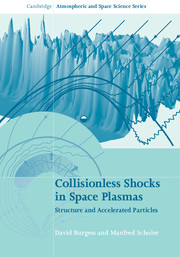Book contents
- Frontmatter
- Contents
- Preface
- Chapter 1 Shocks
- Chapter 2 Basic concepts
- Chapter 3 The quasi-perpendicular shock: macrostructure
- Chapter 4 The quasi-perpendicular shock: microstructure
- Chapter 5 The quasi-parallel shock
- Chapter 6 Diffusive shock acceleration
- Chapter 7 Coherent shock acceleration
- Chapter 8 Electron acceleration
- Chapter 9 Global and modified shocks
- Appendix Simulation techniques
- References
- Further reading
- Index
Chapter 1 - Shocks
Published online by Cambridge University Press: 05 August 2015
- Frontmatter
- Contents
- Preface
- Chapter 1 Shocks
- Chapter 2 Basic concepts
- Chapter 3 The quasi-perpendicular shock: macrostructure
- Chapter 4 The quasi-perpendicular shock: microstructure
- Chapter 5 The quasi-parallel shock
- Chapter 6 Diffusive shock acceleration
- Chapter 7 Coherent shock acceleration
- Chapter 8 Electron acceleration
- Chapter 9 Global and modified shocks
- Appendix Simulation techniques
- References
- Further reading
- Index
Summary
Introduction
A shock is an abrupt transition between supersonic and subsonic flows. The best-known example is that formed by an obstacle, such as an aircraft, travelling through air faster than the speed of sound. For the aircraft to move forward the air ahead of it must be diverted around it, and there has to be a layer of subsonic flow adjacent to the obstacle. If this were not the case the influence of the pressure force, which propagates away from the obstacle at the sound speed, would be swept downstream and could not affect the flow ahead of the obstacle. Relative to the obstacle the distant flow is supersonic, so there has to be a transition to the subsonic flow close to the obstacle.
Considering such transitions within the framework of gas dynamics leads to the study of discontinuous, or near-discontinuous, solutions which must satisfy governing equations such as conservation of mass, momentum and energy. These solutions represent abrupt, well-defined changes in flow state, with so called ‘jumpconditions’ which describe the supersonic to subsonic transition. Two defining qualities can be extracted from this framework. Firstly, at a shock the flow speed changes, but also the temperature increases due to dissipation, so that the shock mediates a transfer of bulk kinetic energy in the upstream flow into thermal energy downstream. The presence of dissipation means that the change of state at a shock corresponds to an entropy increase, and it is irreversible. Secondly, by their nature,shock solutions are fundamentally nonlinear, since not only do they accomplish achange of state, but they can also be thought of as a ‘wave’ whose propagation speed is determined by the supersonic flow speed, i.e., faster than any small-amplitude linear wave. It is nonlinearity which leads to wave steepening at the shock, and the importance of discontinuous solutions.
Shocks have been explored in laboratory plasmas since the 1950s, but the discovery of shocks in interplanetary space, and the confirmation that they are relatively stable structures, has been one of the major advances of space physics. Neverthe-less, the study of shocks in plasmas which are essentially collisionless poses some fundamental problems.
- Type
- Chapter
- Information
- Collisionless Shocks in Space PlasmasStructure and Accelerated Particles, pp. 1 - 26Publisher: Cambridge University PressPrint publication year: 2015



